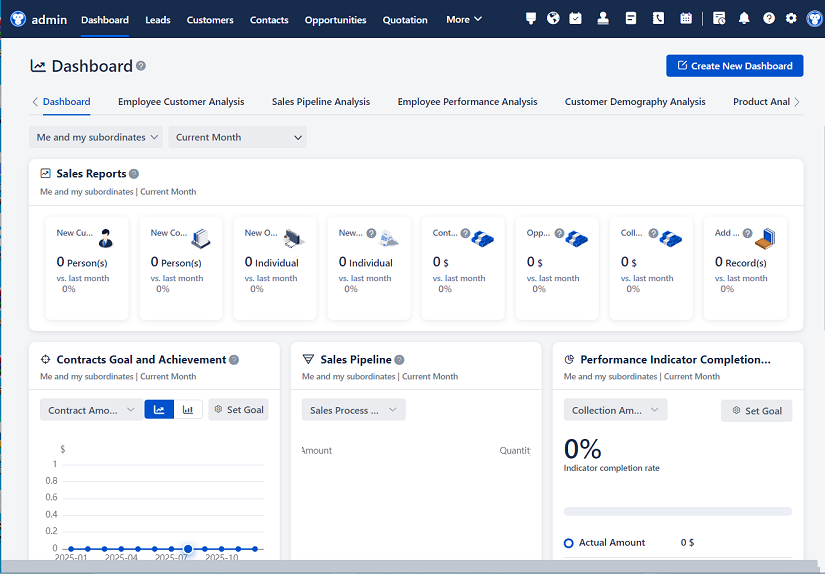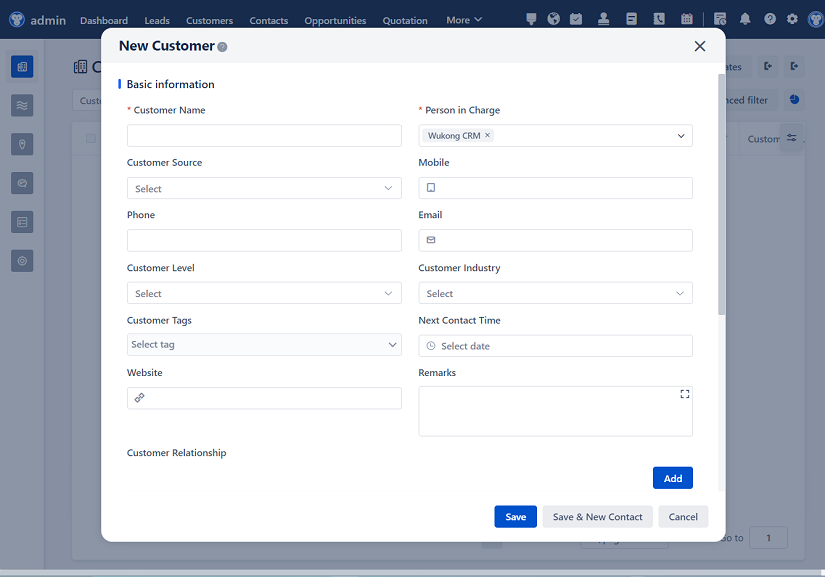
△Click on the top right corner to try Wukong CRM for free
Hey there! So, you've probably heard the term CRM thrown around a lot, right? It stands for Customer Relationship Management, and it's kind of a big deal in the business world. Imagine having a super smart assistant that helps you keep track of all your customers, their preferences, and even predicts what they might want next. That’s what CRM is all about!
Now, let me tell you, I’ve seen a lot of companies using CRM, and it’s not just the big guys. Small businesses, startups, and even freelancers are jumping on the bandwagon. Why? Because it makes life so much easier. Think about it: you have all this data about your customers, but without a good system, it’s like trying to find a needle in a haystack. CRM systems help you organize everything, so you can actually use that data to make better decisions.
One of the coolest things about CRM is how it can help with sales. You know how sometimes you feel like you’re just shooting in the dark when it comes to closing deals? Well, with CRM, you get a clear picture of where each potential customer is in the buying process. It’s like having a map that shows you exactly where to go next. And if you’re in sales, you know how important that is.
But it’s not just about sales. Marketing teams love CRM too. They can use it to send out personalized emails, track which campaigns are working, and even figure out the best time to reach out to customers. It’s like having a crystal ball that tells you what your customers want before they even know it themselves. Pretty neat, huh?

And let’s not forget about customer service. Have you ever called a company, and they already know who you are and what you’ve bought? That’s CRM in action. It helps customer service reps provide a more personalized experience, which, let’s be honest, we all appreciate. No one likes feeling like just another number, right?

So, how do these CRM systems work? Well, they come in different flavors, but most of them have a few key features. First, there’s the contact management part. This is where you store all the information about your customers, like their names, email addresses, and phone numbers. But it’s not just a Rolodex; it’s a smart Rolodex. You can add notes, track interactions, and even set reminders for follow-ups. It’s like having a personal assistant who never forgets anything.

Then there’s the sales pipeline. This is where you can see all your potential deals and where they are in the process. Are they just starting to show interest, or are they ready to sign the contract? The pipeline helps you stay on top of everything, so you don’t miss any opportunities. It’s like having a bird’s-eye view of your entire sales operation.
Another cool feature is the ability to automate tasks. You know how sometimes you have to do the same thing over and over again, like sending out welcome emails or following up with leads? With CRM, you can set up workflows that do all that for you. It’s like having a robot that does the boring stuff, so you can focus on the fun parts of your job.
And then there’s the analytics. This is where CRM really shines. You can get all sorts of reports and insights about your customers, your sales, and your marketing efforts. It’s like having a dashboard that shows you everything you need to know to make your business better. And the best part? You don’t need to be a data scientist to understand it. Most CRM systems make it easy to see what’s working and what’s not.
Now, I know what you’re thinking: “This sounds great, but is it really worth the investment?” Well, that depends on your business, but for most companies, the answer is a resounding yes. Think about it: if you can close more deals, keep your customers happy, and save time, that’s money in the bank. Plus, many CRM systems are pretty affordable, especially when you consider the return on investment.
But here’s the thing: CRM is only as good as the people using it. If you don’t put in the effort to keep it updated and use it properly, it’s not going to do much for you. It’s like buying a fancy gym membership and never going. You’ve got to commit to using it, and that means training your team, setting up processes, and making sure everyone is on board.
And speaking of teams, CRM can really help with collaboration. Imagine if everyone in your company could see the same information and work together seamlessly. No more miscommunications, no more dropped balls. It’s like having a shared brain for your entire organization. And in today’s fast-paced business world, that kind of teamwork can make all the difference.
So, what are some of the popular CRM systems out there? Well, there are a bunch, but some of the big names include Salesforce, HubSpot, and Zoho. Each one has its own strengths, so it’s important to do your research and find the one that fits your needs. For example, if you’re a small business, you might want something simple and easy to use. If you’re a larger enterprise, you might need more advanced features and integrations.

And don’t forget about the cloud. Most modern CRM systems are cloud-based, which means you can access them from anywhere, on any device. It’s like having your CRM in your pocket. This is especially useful if you have a remote team or if you travel a lot. You can stay connected and productive, no matter where you are.
Now, I know some of you might be a little skeptical. Maybe you’ve tried CRM before and it didn’t work out. Or maybe you’re worried about the learning curve. I get it. Change can be hard. But here’s the thing: CRM has come a long way in recent years. The interfaces are more user-friendly, the support is better, and the benefits are real. It’s not just a fad; it’s a tool that can genuinely transform your business.
And if you’re still on the fence, think about your competition. Chances are, they’re already using CRM. If you don’t, you might be at a disadvantage. It’s like running a race with one hand tied behind your back. You can do it, but why make it harder on yourself?

So, what’s the first step? Well, the best place to start is by assessing your needs. What are your biggest pain points? Do you need help with sales, marketing, or customer service? Once you know what you need, you can start looking at different CRM options. Many providers offer free trials, so you can test them out and see which one works best for you.
And remember, implementation is key. Don’t just buy a CRM and expect it to work miracles. You need to train your team, set up your processes, and make sure everyone is using it consistently. It’s like planting a garden; you can’t just throw some seeds in the ground and hope for the best. You need to water it, weed it, and give it some TLC.
In the end, CRM is all about building better relationships with your customers. And in today’s world, where customers have more choices than ever, those relationships are more important than ever. So, if you’re not already using CRM, now might be the time to give it a try. Trust me, your customers (and your bottom line) will thank you.
Alright, I know that was a lot, so let me wrap it up with a few questions to help you think about CRM in your own business:
- What are the main challenges you face in managing customer relationships, and how could a CRM system help?
- How do you currently track your sales pipeline, and do you think a CRM could make it more efficient?
- What kind of data do you collect about your customers, and how could a CRM help you use that data more effectively?
- Have you considered the benefits of a cloud-based CRM, and how it could improve collaboration and accessibility for your team?
- What steps would you need to take to successfully implement a CRM system in your organization, and how would you ensure everyone is on board?

I hope this helps, and if you have any more questions, feel free to ask!
Related links:
Free trial of CRM
Understand CRM system
AI CRM Systems

△Click on the top right corner to try Wukong CRM for free